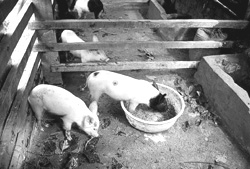Ominous gene transfer
 the researchers in us have uncovered evidence of a new route by which dangerous antibiotic-resistance genes can spread. The bacteria in the soil and groundwater beneath farms seem to be acquiring tetracycline-resistant genes from bacteria originating in pig guts.
the researchers in us have uncovered evidence of a new route by which dangerous antibiotic-resistance genes can spread. The bacteria in the soil and groundwater beneath farms seem to be acquiring tetracycline-resistant genes from bacteria originating in pig guts.
Once transferred, the resistance genes can persist in the hardier soil and water-borne bacteria and pass on to potentially dangerous bacteria in the environment or to humans who drink the water. "The study is the first of its kind to demonstrate this kind of broad ecological presence of tetracycline-resistance genes,' says Stuart Levy, director of the Center for Adaptation Genetics and Drug Resistance at Tufts University, Boston, usa. While the European Union has banned the use of growth promoter antibiotics that are used in medicines, farmers in the us still routinely add antibiotics such as tetracycline, pencillin and streptomycin to livestock feed to promote animal growth.
Nearly 70 per cent of all antibiotics produced in the us are fed to animals as growth promoters, according to the Union of Concerned Scientists, a non-profit organisation based in Cambridge, Massachusetts, usa .
To study the environmental effect of these antibiotics in two swine farms that use tetracycline as growth promoter, researchers analysed samples from farm-waste lagoons and from groundwater reservoirs beneath the lagoons. They found that bacteria in the soil and groundwater carried tetracycline-resistant genes, or tet genes, that were almost identical to those in bacteria living in the pigs' guts. This proved that the bacteria from the pigs were transferring their genes to the ones outside.
Abigail Salyers, researcher at the University of Illinois, usa, and her colleagues had earlier shown that bacteria passing through human intestines exchange genes with the resident bacteria. They had found that 80 per cent of the strains of a major bacterial species found in the colons of people in the late 1990s carried tetracycline resistance genes as compared to just 30 per cent recorded in 1970.
"What we have observed is that if a resistance gene gets out into the bacterial population in nature, it's like letting the genie out of the bottle. So far it looks like there are very few, if any, limits to how far a resistance gene can spread,' said Salyers.
